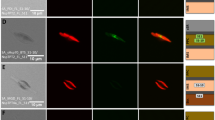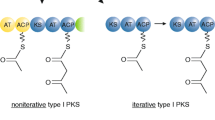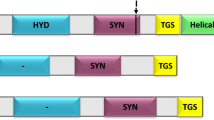Abstract
Diatom plastids probably evolved by secondary endocytobiosis from a red alga that was up by a eukaryotic host cell. Apparently, this process increased the complexity of the intracellular distribution of metabolic enzymes. We identified genes encoding fructose-bisphosphate aldolases (FBA) in two centric (Odontella sinensis, Thalassiosira pseudonana) and one pennate (Phaeodactylum tricornutum) diatoms and found that four different aldolases are present in both groups: two plastid targeted class II enzymes (FBAC1 and FBAC2), one cytosolic class II (FBA3) and one cytosolic class I (FBA4) enzyme. The pennate Phaeodactylum possesses an additional plastidic class I enzyme (FBAC5). We verified the classification of the different aldolases in the diatoms by enzymatic characterization of isolated plastids and whole cell extracts. Interestingly, our results imply that in plastids of centric and pennate diatoms mainly either class I or class II aldolases are active. We also identified genes for both class I and class II aldolases in red algal EST databases, thus presenting a fascinating example of the reutilization and recompartmentalization of different aldolase isoenzymes during secondary endocytobiosis but as well demonstrating the limited use of metabolic enzymes as markers for the interpretation of phylogenetic histories in algae.





Similar content being viewed by others
References
Antia NJ (1967) Comparative studies on aldolase activity in marine planktonic algae, and their evolutionary significance. J Phycol 3:91–85
Apt KE, Zaslavkaia L, Lippmeier JC, Lang M, Kilian O, Wetherbee R, Grossman AR, Kroth PG (2002) In vivo characterization of diatom multipartite plastid targeting signals. J Cell Sci 115:4061–4069
Armbrust et al (2004) The genome of the diatom Thalassiosira pseudonana: ecology, evolution, and metabolism. Science 306:79–86
Bhaya D, Grossman A (1991) Targeting proteins to diatom plastids involves transport through an endoplasmic reticulum. Mol Gen Genet 229:400–404
Blom N, Sygusch J (1997) Product binding and role of the C-terminal region in class I D-fructose 1,6-bisphosphate aldolase. Nat Struct Biol 4:36–39
Cavalier-Smith T (2000) Membrane heredity and early chloroplast evolution. Trends Plant Sci 5:174–182
Cavalier-Smith T (2003) Genomic reduction and evolution of novel genetic membranes and protein-targeting machinery in eukaryote-eukaryote chimeras (meta-algae). Philos Trans R Soc Lond B Biol Sci 359:109–134
Delwiche CF, Palmer JD (1997) The origin of plastids and their spread via secondary endosymbiosis. Plant Syst Evol 11:53–86
Emanuelsson O, Nielsen H, von Heijne G ((1999)) “ChloroP, a neural network-based method for predicting chloroplast transit peptides and their cleavage sites”. Protein Sci 8.5:978–984
Flechner A, Gross W, Martin WF, Schnarrenberger C (1999) Chloroplast class I and class II aldolases are bifunctional for fructose-1,6-biphosphate and sedoheptulose-1,7-biphosphate cleavage in the Calvin cycle. FEBS Lett 447:200–202
Gross W, Bayer MG, Schnarrenberger C, Gebhart UB, Maier TL, Schenk H (1994) Two distinct aldolases of class II type in the cyanoplasts and in the cytosol of the alga Cyanophora paradoxa. Plant Physiol 105:1393–1398
Gross W, Lenze D, Nowitzki U, Weiske J, Schnarrenberger C (1999) Characterization, cloning, and evolutionary history of the chloroplast and cytosolic class I aldolases of the red alga Galdieria sulphuraria. Gene 230:7–14
Guindon S, Gascuel O (2003) A simple, fast, and accurate algorithm to estimate large phylogenies by maximum likelihood. Syst Biol 52:696–704
Henze K, Morrison HG, Sogin ML, Müller M (1998) Sequence and phylogenetic position of a class II aldolase gene in the amitochondriate protist, Giardia lamblia. Gene 222:163–168
Kilian O, Kroth PG (2004) Presequence acquisition during secondary endocytobiosis and the possible role of introns. J Mol Evol 58:712–721
Kilian O, Kroth PG (2005) Identification and characterization of a new conserved motif within the presequence of proteins targeted into complex diatom plastids. Plant J 41:175–183
Kowallik KV (2003) Diatoms: a complex evolutionary history becomes even more complex. J Phycol 39:1–3
Kumar S, Tamura K, Nei M (2004) MEGA3: Integrated software for Molecular Evolutionary Genetics Analysis and sequence alignment. Briefings Bioinformat 5:150–163
Kroth PG (2002) Protein transport into secondary plastids and the evolution of primary and secondary plastids. Int Rev Cytol 221:191–255
Lang M, Apt KE, Kroth PG (1998) Protein transport into “complex” diatom plastids utilizes two different targeting signals. J Biol Chem 273:30973–30978
Maheswari U, Montsant A, Goll J, Krishnasamy S, Rajyashri KR, Patell VM, Bowler C (2005) The diatom EST database. Nucleic Acids Res 33:D344–D347
Martin W, Herrmann RG (1998) Gene transfer from organelles to the nucleus: How much, what happens, and why? Plant Physiol 118(1998):9–17
Martin W, Mustafa AZ, Henze K, Schnarrenberger C (1996) Higher-plant chloroplast and cytosolic fructose-1,6-bisphosphatase isoenzymes: origins via duplication rather than prokaryote-eukaryote divergence. Plant Mol Biol 32:485–491
Martin W, Scheibe R, Schnarrenberger C (2000) The Calvin cycle and its regulation. In: Leegood RC, Sharkey TD, von Caemmerer S (eds) Advances in photosynthesis, vol 9. Photosynthesis: physiology and metabolism. Kluwer Academic Publishers, Dordrecht, pp 9–51
Marsh JJ, Lebherz HG (1992) Fructose-bisphosphate aldolases: an evolutionary history. Trends Biochem Sci 17:110–113
Matsuzaki M et al. (2004) Genome sequence of the ultrasmall unicellular red alga Cyanidioschyzon merolae 10D. Nature 428:653–657
McFadden GI (2001) Primary and secondary endosymbiosis and the origin of plastids. J Phycol 37:951–959
Montsant A, Jabbari K, Maheswari U, Bowler C (2005) Comparative genomics of the pennate diatom Phaeodactylum tricornutum. Plant Physiol 137:500–513
Moreira D, Le Guyader H, Philippe H (2000) The origin of red algae and the evolution of chloroplasts. Nature 405:69–72
Mutoh N, Hayashi Y (1994) Molecular cloning and nucleotide sequencing of Schizosaccharomyces pombe homologue of the class II fructose-1,6-bisphosphate aldolase gene. Biochim Biophys Acta 1183:550–552
Nielsen H, Brunak S, von Heijne G (1999) Machine learning approaches for the prediction of signal peptides and other protein sorting signals. Protein Eng 12:3–9
Nikaido I, Asamizu E, Nakajima M, Nakamura Y, Saga N, Tabata S (2000) Generation of 10,154 expressed sequence tags from a leafy gametophyte of a marine red alga, Porphyra yezoensis. DNA Res 7:223–227
Nisbet RE, Kilian O, McFadden GI (2005) Diatom genomics: genetic acquisitions and mergers. Curr Biol 14:R1048–R1050
Palmer JD (1993) A genetic rainbow of plastids. Nature 364:762–763
Palmer JD (2003) The symbiotic birth and spread of plastids: how many times and whodunnit? J Phycol 39:4–11
Patron NJ, Rogers MB, Keeling PJ (2004) Gene replacement of fructose-1,6-bisphosphate aldolase supports the hypothesis of a single photosynthetic ancestor of chromalveolates. Euk Cell 3:1169–1175
Pancic P, Strotmann H (1990) Characterization of CF1 from the diatom Odontella sinensis. Bot Acta 103:274–280
Pancic PG, Strotmann H (1993) Structure of the nuclear encoded γ subunit of CF0CF1 of the diatom Odontella sinensis including its presequence. FEBS Lett 320:61–66
Pelzer-Reith B, Freund S, Schnarrenberger C, Yatsuki H, Hori K (1995) The plastid aldolase gene from Chlamydomonas reinhardtii: intron/exon organization, evolution, and promoter structure. Mol Gen Genet 248:481–486
Pelzer-Reith B, Penger A, Schnarrenberger C (1993) Plant aldolase: cDNA and deduced amino-acid sequences of the chloroplast and cytosol enzyme from spinach. Plant Mol Biol 21:331–340
Plaumann M, Pelzer-Reith B, Martin WF, Schnarrenberger C (1997) Multiple recruitment of class-I aldolase to chloroplasts and eubacterial origin of eubacterial eukaryotic class-II aldolases revealed by cDNAs from Euglena gracilis. Curr Genet 31:430–438
Rodríguez-Ezpeleta N, Brinkmann H, Burey S, Roure B, Burger G, Löffelhardt W, Bohnert H, Philippe H, Lang B (2005) Monophyly of primary photosynthetic eukaryotes: green plants, red algae, and glaucophytes. Curr Biol 15:1325–1330
Rutter WJ (1964) Evolution of aldolases. Fed Proc 23:1248–1257
Schmid A-MM (2003) Endobacteria in the diatom Pinnularia (Bacillariophyceae). I. “Scattered ct-nucleoids” explained: DAPI-DNA complexes stem from exoplastidial bacteria boring into the chloroplasts. J Phycol 39:122–138
Schnarrenberger C, Pelzer-Reith B, Yatsuki H, Freund S, Jacobshagen S, Hori K (1994) Expression and sequence of the only detectable aldolase in Chlamydomonas reinhardtii. Arch Biochem Biophys 313:173–178
Siebers B, Brinkmann H, Dorr C, Tjaden B, Lilie H, van der Oost J, Verhees CH (2001) Archaeal fructose-1,6-bisphosphate aldolases constitute a new family of archaeal type class I aldolase. J Biol Chem 276:28710–28718
Smetacek V (1999) Diatoms and the ocean carbon cycle. Protist 150:25–32
Starr RC, Zeikus JA (1993) UTEX-The culture collection of algae at the University of Texas at Austin. J Phycol 29(Suppl):93
Stiller JW, Reel DC, Johnson JC (2003) A single origin of plastids revisited: convergent evolution in organellar genome content. J Phycol 39:95–105
Tolstrup N, P Rouze, Brunak S (1997) A branch point consensus from Arabidopsis found by non-circular analysis allows for better prediction of acceptor sites. Nucleic Acids Res 25:3159–3163
Treguer P, Nelson DM, Van Bennekom AJ, DeMaster DJ, Leynaert A, Queguiner B (1995) The silica balance in the world ocean - a reestimate. Science 268:375–379
Waller RF, Reed MB, Cowman AF, McFadden GI (2000) Protein trafficking to the plastid of Plasmodium falciparum is via the secretory pathway. EMBO J 19:1794–1802
Witke C, Götz F (1993) Cloning, sequencing, and characterization of the gene encoding the class I fructose-1,6-bisphosphate aldolase of Staphylococcus carnosus. J Bacteriol 175:7495–7499
Wittpoth C, Kroth PG, Weyrauch K, Kowallik KV, Strotmann H (1998) Functional characterization of isolated plastids from two marine diatoms. Planta 206:79–85
Zaslavskaia LA, Lippmeier JC, Kroth PG, Grossman AR, Apt KE (2000) Transformation of the diatom Phaeodactylum tricornutum (Bacillariophyceae) with a variety of selectable marker and reporter genes. J Phycol 36:379–386
Zaslavskaia LA, Lippmeier JC, Shih C, Ehrhardt D, Grossman AR, Apt KE (2001) Trophic obligate conversion of an photoautotrophic organism through metabolic engineering. Science 292:2073–2075
Acknowledgements
The authors are grateful for support by the University of Konstanz and for grants of the Deutsche Forschungsgemeinschaft (DFG, project Kr 1661/3-1) and the European community (MARGENES, contract QLRT-2001-01226) to PGK. We thank BASF Plant Science GmbH (Ludwigshafen, Germany) for participating in an EST sequencing program.
Author information
Authors and Affiliations
Corresponding author
Additional information
Communicated by R. Bock
The nucleotide sequences have been deposited at Genbank under the accession numbers AY116588, AY191866 and AY212505
Rights and permissions
About this article
Cite this article
Kroth, P.G., Schroers, Y. & Kilian, O. The peculiar distribution of class I and class II aldolases in diatoms and in red algae. Curr Genet 48, 389–400 (2005). https://doi.org/10.1007/s00294-005-0033-2
Received:
Revised:
Accepted:
Published:
Issue Date:
DOI: https://doi.org/10.1007/s00294-005-0033-2




